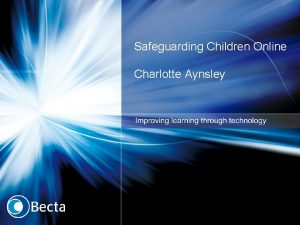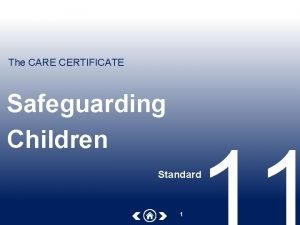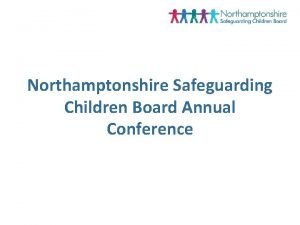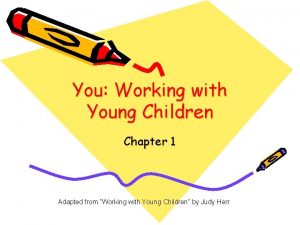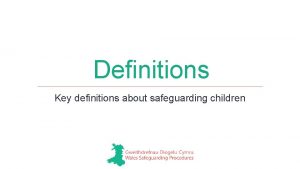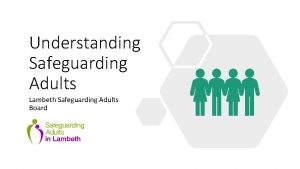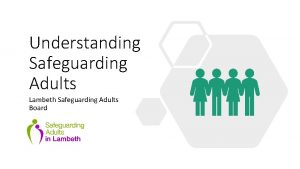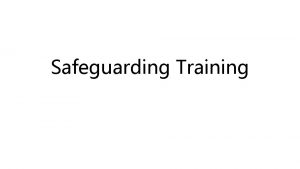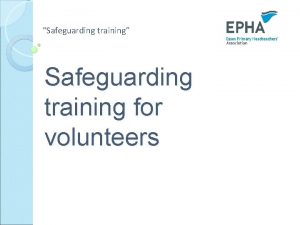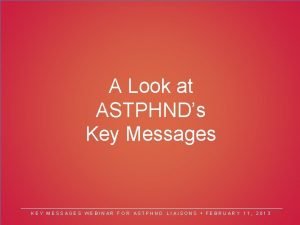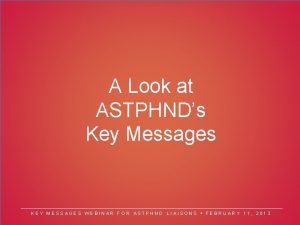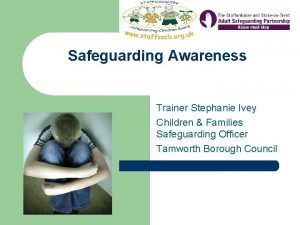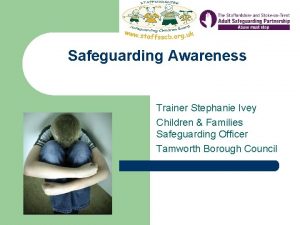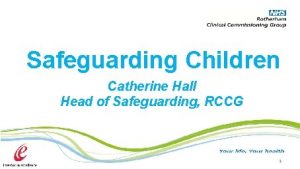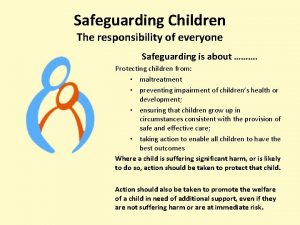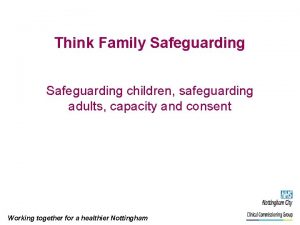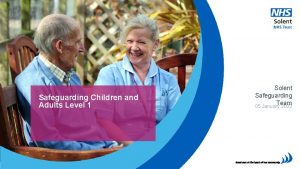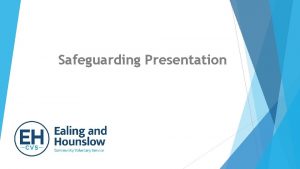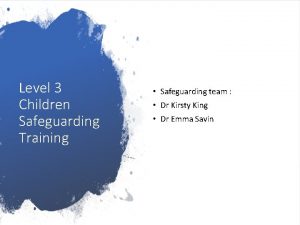Safeguarding Children Online Charlotte Aynsley Key messages for


































- Slides: 34

Safeguarding Children Online Charlotte Aynsley

Key messages for today • • • Web 1. 0 Web 2. 0 Relevant policies and legislation Issues and risks Role of the school/organisation Support available What do you need to do?

Childnet International Change in Technology and Usage WEB v 1 WEB v 2 Downloading + Uploading Consuming + Creating “Corporate” + Personal Separate media + Converged media Static + Truly interactive

Why should I be concerned about e-safety? • • Every Child Matters: Change for children – Be healthy – Stay safe – Enjoy and achieve – Make a positive contribution – Achieve economic well-being Safeguarding Children in Education – Sept 2004 Working Together to Safeguard Children (11. 58 -11. 62) Practitioners need to know that ICT is safe if they are to take advantage of its benefits Schools have a duty of care - both inside and outside Df. ES – ‘Harnessing Technology’ – the e-strategy – ‘personalising learning’ Self Evaluation Framework – 4 b To what extent do learners feel safe and adopt safe practices? The extent to which learners adopt safe and responsible practices in using new technologies, including the Internet.

What are the risks? • • Content -sexual, racist, violent unreliable/bigoted ie safety of children’s minds Commerce - scams, phishing and pharming, bluejacking, downloads which steal information– children’s and parents! Contact - via interactive technologies – IM, chat, multiplayer games Culture – cyberbullying, camera phones, blogging, moblogging, social networking …. . • The ‘C’ of ICT is the most dangerous ie Communication which can lead to Contact • Approx 40 - 50 cases in the last 4 -5 years compared to 500 serious road casualties per year! • The biggest Internet danger is that we concentrate on the dangers and forget the benefits! Balance and perspective •

Schools should be raising awareness of: • Internet safety – ‘People online may not be who they say they are’ – keeping personal information secret across all technologies – email, chat, IM, mobile – bullying across all technologies including camera phones & blogs • Internet security – ‘If it looks too good to be true it generally is’ – spotting copycats websites and scams – viruses and spam via email • Media literacy – ‘Who wrote this and why? ’ – evaluating reliability/validity of information – copyright and plagiarism – P 2 P networks - allow anyone to publish videos and large files to anyone who needs them eg Napster and Gnutella, music and porn!

Issues for schools to consider • • Who is responsible for teaching e-safety? At what age should internet safety lessons start? How can parents be involved? What support is there in schools for teachers in the event of a ‘disclosure’? Advent of 3 G and ‘mobile internet’ Data security – PASSWORDS! External issues being brought into school eg cyberbullying Protection for staff – AUP’s

Are you prepared for the following? • Parental query: staff using own ICT devices to capture pictures or contact pupils (legitimately!!) • Staff personal online profiles revealing personal details to all – including pupils and their parents! • Staff subject to cyberbullying attacks by pupils • ‘Their partner downloaded porn on the school’s laptop’ - primary head teacher • ‘The monitoring software recorded tens of thousands of violations in a two week period’ - secondary head teacher • ‘There’s a website created by my pupils listing children no one likes and their parents are telling me to do something about it’ - primary head teacher • ‘The children use their mobile phones to send porn via bluetooth’ - primary head teacher

Key measures

Policy and procedure - what help is available? Becta’s Schools website http: //www. becta. org. uk/schools/esafety • E-safety: a whole school approach - currently being updated Main recommendations: • E-safety co-ordinator • Policy and management team • Checklists of AUPs • Incident log • Safetynet discussion forum

Support for LAs/LSCBs – (new materials being developed) Main recommendations: • A responsible officer • AUPs for all children’s services • Clear incident procedures and reporting lines • Accredited ISP • Training cascaded to services • Regular evaluation, assessment and monitoring of provision across the LSCB

Infrastructure - what help is available? • ISP Safety site http: //ispsafety. ngfl. gov. uk • Becta Accreditation of Internet Services to Education: enables schools to purchase services from accredited suppliers that meet and maintain specific standards in content filtering and service performance. • Delivering the National Digital Infrastructure – Robust and reliable networks – Secure and safe access to data and content via the National Education Network – Best value purchasing – Technical support and services – Finding choosing and using resources – Personalised learning spaces

Key resources by audience • SMT e-Safety: Developing whole-school policies to support effective practice • Classroom teachers Signposts to Safety • Support staff TDA Primary induction – ICT – For teaching assistant trainers • Governors ICT: essential guides for school governors No. 06 - Safety and security with ICT • Local Authority and LSCB personnel Safeguarding children in a digital world; Developing a strategic approach to e-safety’ Safeguarding Children Online: a guide for Local Authorities and Local Safeguarding Children Boards • Parents Know ITAll for Parents – Childnet International • Children & Young People Think. UKnow - CEOP

NEW! DCSF Cyberbullying guidance www. teachernet. gov. uk/wholeschool/behaviour/tacklingbullying www. digizen. org/ …. . features ‘Let’s Fight it Together’ a powerful film produced by Childnet International

Training for education professionals • UCLAN – Course code FZ 1072 - www. internetsafetyzone. co. uk • NSPCC - packs@nspcc. org. uk • CEOP - education@ceop. gov. uk

Resources for trainees, practicing teachers and adults who work with children



What should schools/organisations be doing? • Be alert to the possibilities! • Provide: - Policies and procedures - Infrastructure - Education for staff, parents, students - Standards and inspection (School Evaluation Framework) • 4 b the extent to which learners adopt safe and responsible practices in using new technologies, including the Internet.

Charlotte Aynsley British Educational Communications and Technology Agency (Becta) Millburn Hill Road Science Park Coventry CV 4 7 JJ • • • • Tel: 02476 416994 Fax: 02476 411418 www. becta. org. uk Charlotte. aynsley@becta. org. uk

Stay Safe: • • • From maltreatment, neglect, violence and sexual exploitation From accidental injury and death From bullying and discrimination From crime and anti-social behaviour in and out of school Have security, stability and are cared for These aims were written with the ‘real’ world in mind, however many equally apply to the ‘virtual’ world of 21 st century

Concerns are shifting from what children are ‘downloading’ in terms of content to what they are ‘uploading’ to the net.

Reliability and bias? http: //zapatopi. net/treeoctopus/

Parental security concerns underlie Fisher. Price's Easy-Link Internet Launchpad, a keyboardfree console for the 3 -and -older crowd. When toddlers stick a figurine representing one of their favorite licensed characters (Elmo, Bob the Builder, Thomas the Train) into its appropriate console slot, they are whisked directly to the character's official website, where all the games are ageappropriate and there's nary a pornographic banner ad in sight. Feb 07



What’s different about CYBERBULLYING ? • • • Physical intimidation has changed (teachers can be bullied) Perception of anonymity Say things that would not say face to face (lack of empathy) 24/7 contact – no escape even when at home Bystander effect (others can get caught up) Don’t necessarily see the affect of the behaviour on the victim (“just a bit of fun!”) Re-victimisation even time the content is viewed Long lasting consequences Potentially stay online forever (no closure). Parents may not know (fear of technology confiscated) Childnet International 2007

Read the small print! • Section 10(2) of the Children Act defines well being as: "(a) physical and mental health and emotional well-being; (b) protection from harm and neglect; • Health and Safety at Work Act 1974 puts a personal responsibility for employee and pupil safety on the governing body • If there is a school e-safety lapse caused by inadequate school spending on demonstrably desirable or evidently necessary protections the head teacher is trebly to blame as having day to day responsibility for both school safety and the school budget and as a governor.






http: //www. children-go-online. net/ ‘. . the risks do not merit a moral panic, and nor do they warrant seriously restricting children’s internet use because this would deny them the many benefits of the internet. Indeed, there are real costs to lacking internet access or sufficient skills to use it. ’ ‘However, the risks are nonetheless widespread, they are experienced by many children as worrying or problematic, and they do warrant serious intervention by government, educators, industry and parents. ’
 Charlotte aynsley
Charlotte aynsley Safeguarding children care certificate
Safeguarding children care certificate Birmingham safeguarding adults board
Birmingham safeguarding adults board Northamptonshire safeguarding
Northamptonshire safeguarding Contoh key partners
Contoh key partners Key partners key activities key resources
Key partners key activities key resources Secure key loader
Secure key loader Working with young children/answer key chapter 1
Working with young children/answer key chapter 1 Formuö
Formuö Novell typiska drag
Novell typiska drag Tack för att ni lyssnade bild
Tack för att ni lyssnade bild Returpilarna
Returpilarna Shingelfrisyren
Shingelfrisyren En lathund för arbete med kontinuitetshantering
En lathund för arbete med kontinuitetshantering Särskild löneskatt för pensionskostnader
Särskild löneskatt för pensionskostnader Vilotidsbok
Vilotidsbok Sura för anatom
Sura för anatom Densitet vatten
Densitet vatten Datorkunskap för nybörjare
Datorkunskap för nybörjare Tack för att ni lyssnade bild
Tack för att ni lyssnade bild Att skriva debattartikel
Att skriva debattartikel Delegerande ledarskap
Delegerande ledarskap Nyckelkompetenser för livslångt lärande
Nyckelkompetenser för livslångt lärande Påbyggnader för flakfordon
Påbyggnader för flakfordon Lufttryck formel
Lufttryck formel Offentlig förvaltning
Offentlig förvaltning Jag har nigit för nymånens skära text
Jag har nigit för nymånens skära text Presentera för publik crossboss
Presentera för publik crossboss Argument för teckenspråk som minoritetsspråk
Argument för teckenspråk som minoritetsspråk Bat mitza
Bat mitza Treserva lathund
Treserva lathund Luftstrupen för medicinare
Luftstrupen för medicinare Claes martinsson
Claes martinsson Cks
Cks Byggprocessen steg för steg
Byggprocessen steg för steg
